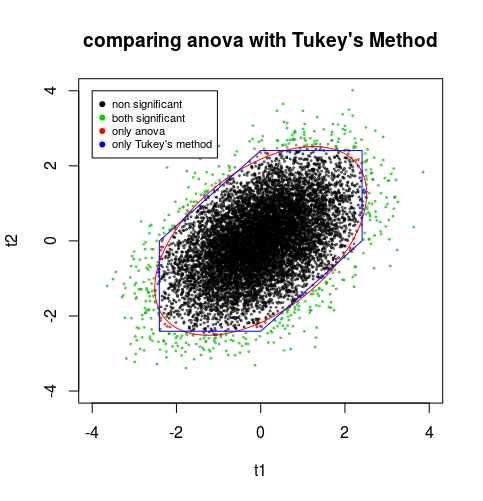It is possible to find discrepancies between the results of ANOVA and post-hoc tests. The results of post-hoc tests are valid (with the exception of the Fisher LSD test) even if the overall P value for the ANOVA is greater than 0.05 (1, 2, 3, 4).
How should such results be presented and interpreted? There are some questions on this subject, but the answers are more or less theoretical (5, 6, 3, 4). I could not find any papers (biology, ecology and related fields) with such results.
Therefore, I would like to know how to present and interpret such results using a real example: I used a linear mixed model (function lmer, R package lme4) to analyse the effect of cover of two invasive plant species (Solidago spp.) on the diversity of invaded plant communities. The response variable is species richness, the explanatory variables are categorical - invasive species (2 levels: S. canadensis and S. gigantea), cover of invasive species (3 levels: C = ~0%, T = ~30% and D = ~80%) and their interaction.
While the results of the anova (function Anova, type 3 and 2; package car) suggest no significant interaction, visual inspection of the boxplot suggests the opposite, which was confirmed by post-hoc tests (function avg_comparisons from the package marginaleffects). See below.
So how should I present and interpret these results?
(By the way, why are there no values for intercept in the type 2 Anova outputs?)
R script:
> library(lme4)
> library(car)
> library(MuMIn)
> library(marginaleffects)
> m1<-lmer(Hillall_0 ~ solidago * plot + (1 | locality), data=dat)
> Anova(m1, type="III", icontrasts=c("contr.sum", "contr.poly"))
Analysis of Deviance Table (Type III Wald chisquare tests)
Response: Hillall_0
Chisq Df Pr(>Chisq)
(Intercept) 185.7266 1 < 2.2e-16 ***
solidago 8.4379 1 0.0036749 **
plot 16.4066 2 0.0002737 ***
solidago:plot 4.7866 2 0.0913297 .
---
Signif. codes: 0 ‘***’ 0.001 ‘**’ 0.01 ‘*’ 0.05 ‘.’ 0.1 ‘ ’ 1
> Anova(m1, type="II")
Analysis of Deviance Table (Type II Wald chisquare tests)
Response: Hillall_0
Chisq Df Pr(>Chisq)
solidago 14.3900 1 0.0001486 ***
plot 12.8453 2 0.0016243 **
solidago:plot 4.7866 2 0.0913297 .
---
Signif. codes: 0 ‘***’ 0.001 ‘**’ 0.01 ‘*’ 0.05 ‘.’ 0.1 ‘ ’ 1
> r.squaredGLMM(m1, pj2014 = F)
R2m R2c
[1,] 0.3518038 0.3518038
Post-hoc tests:
> avg_comparisons(m1, variables = "solidago", by = "plot")
Term Contrast plot Estimate Std. Error z Pr(>|z|) S 2.5 % 97.5 %
solidago mean(gigantea) - mean(canadensis) C -12.6 4.34 -2.905 0.00367 8.1 -21.1 -4.1
solidago mean(gigantea) - mean(canadensis) D -1.8 4.34 -0.415 0.67816 0.6 -10.3 6.7
solidago mean(gigantea) - mean(canadensis) T -14.1 4.34 -3.251 0.00115 9.8 -22.6 -5.6
Columns: term, contrast, plot, estimate, std.error, statistic, p.value, s.value, conf.low, conf.high, predicted_lo, predicted_hi, predicted
Type: response
> avg_comparisons(m1, variables = "plot", by = "solidago")
Term Contrast solidago Estimate Std. Error z Pr(>|z|) S 2.5 % 97.5 %
plot mean(D) - mean(C) canadensis -15.6 4.34 -3.596 <0.001 11.6 -24.1 -7.1
plot mean(D) - mean(C) gigantea -4.8 4.34 -1.107 0.268 1.9 -13.3 3.7
plot mean(T) - mean(C) canadensis -0.8 4.34 -0.184 0.854 0.2 -9.3 7.7
plot mean(T) - mean(C) gigantea -2.3 4.34 -0.530 0.596 0.7 -10.8 6.2
Columns: term, contrast, solidago, estimate, std.error, statistic, p.value, s.value, conf.low, conf.high, predicted_lo, predicted_hi, predicted
Type: response
> avg_comparisons(m1, variables = "solidago", by = "plot", hypothesis = "pairwise")
Term Estimate Std. Error z Pr(>|z|) S 2.5 % 97.5 %
C - D -10.8 6.13 -1.761 0.0783 3.7 -22.823 1.22
C - T 1.5 6.13 0.245 0.8068 0.3 -10.523 13.52
D - T 12.3 6.13 2.005 0.0450 4.5 0.277 24.32
Columns: term, estimate, std.error, statistic, p.value, s.value, conf.low, conf.high
Type: response
> avg_comparisons(m1, variables = "plot", by = "solidago", hypothesis = "pairwise")
Term Estimate Std. Error z Pr(>|z|) S 2.5 % 97.5 %
(mean(D) - mean(C), canadensis) - (mean(D) - mean(C), gigantea) -10.8 6.13 -1.761 0.0783 3.7 -22.8 1.22
(mean(D) - mean(C), canadensis) - (mean(T) - mean(C), canadensis) -14.8 4.34 -3.412 <0.001 10.6 -23.3 -6.30
(mean(D) - mean(C), canadensis) - (mean(T) - mean(C), gigantea) -13.3 6.13 -2.168 0.0301 5.1 -25.3 -1.28
(mean(D) - mean(C), gigantea) - (mean(T) - mean(C), canadensis) -4.0 6.13 -0.652 0.5144 1.0 -16.0 8.02
(mean(D) - mean(C), gigantea) - (mean(T) - mean(C), gigantea) -2.5 4.34 -0.576 0.5644 0.8 -11.0 6.00
(mean(T) - mean(C), canadensis) - (mean(T) - mean(C), gigantea) 1.5 6.13 0.245 0.8068 0.3 -10.5 13.52
Columns: term, estimate, std.error, statistic, p.value, s.value, conf.low, conf.high
Type: response


